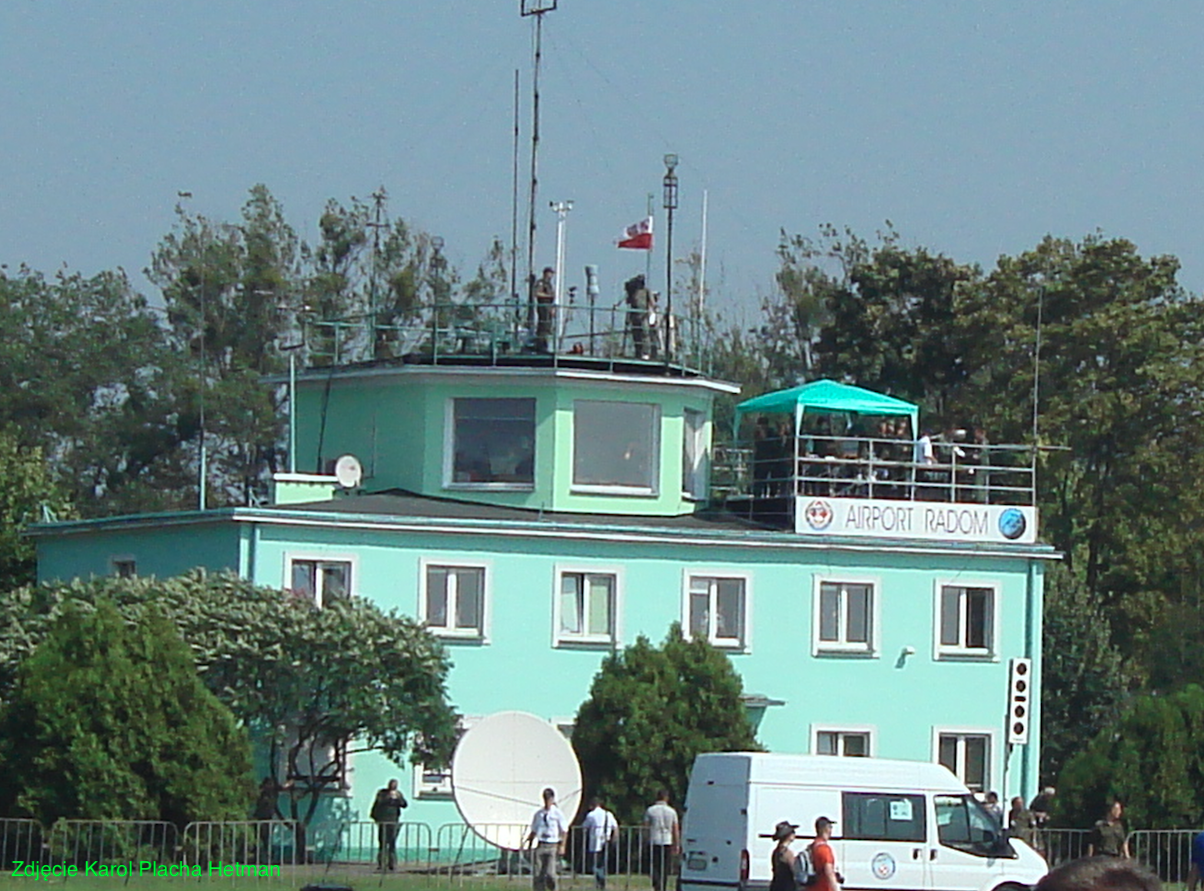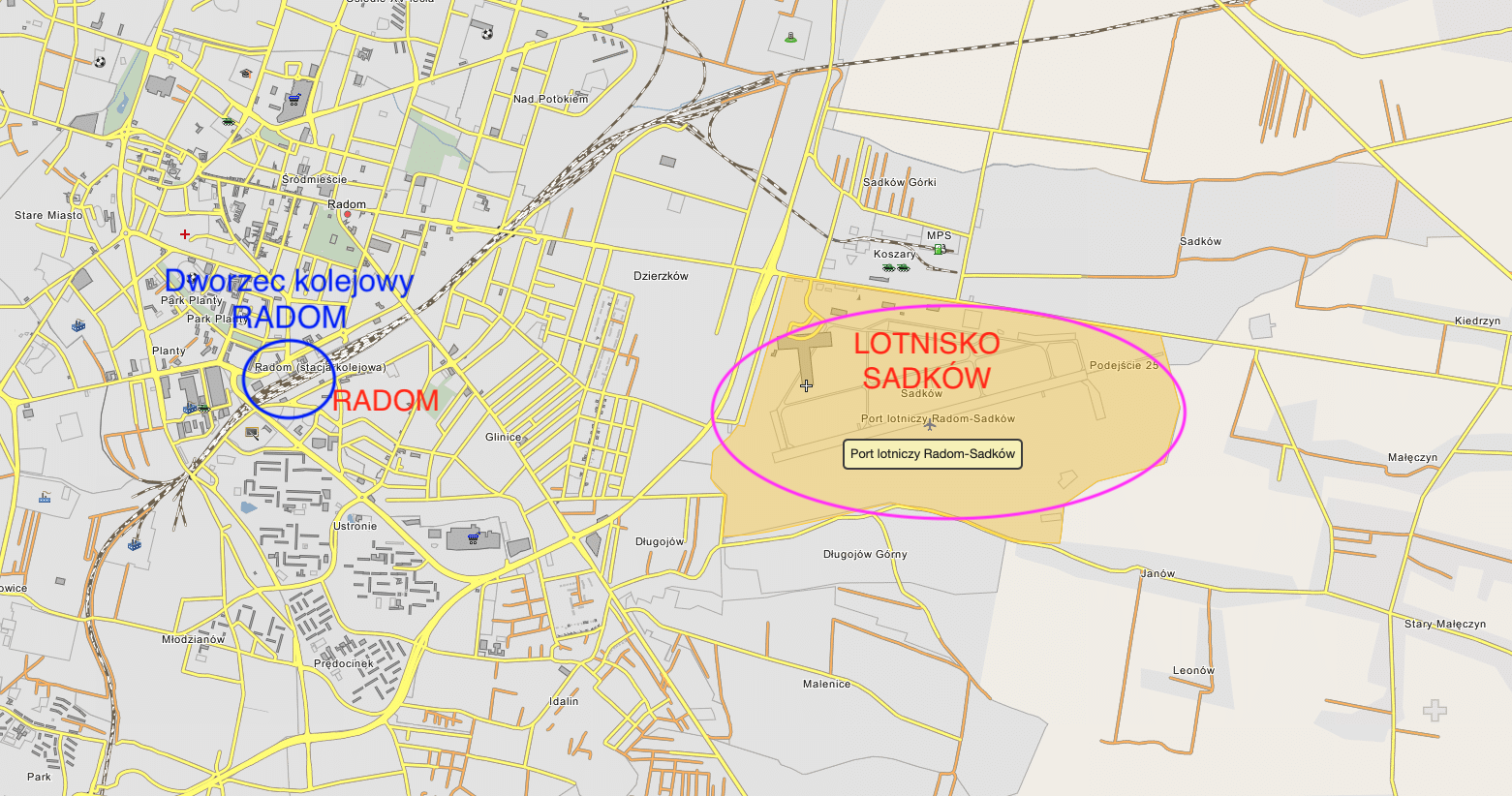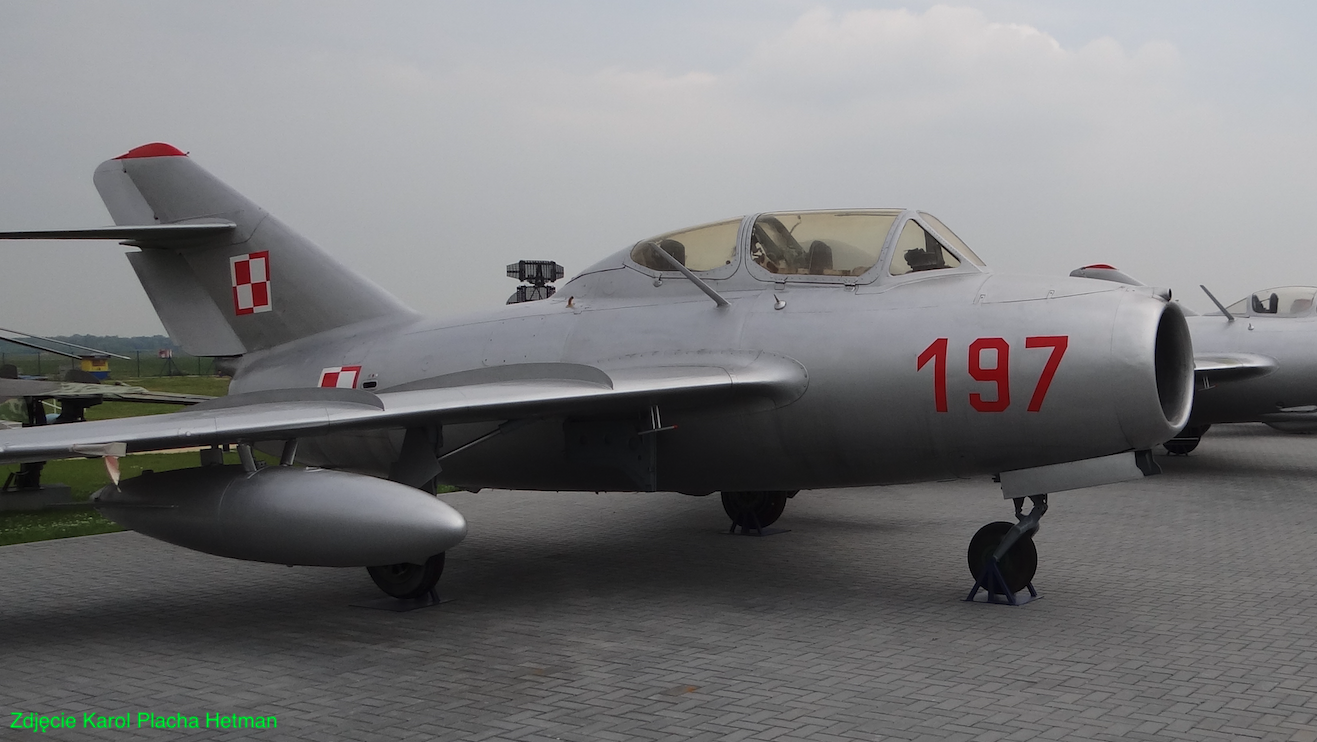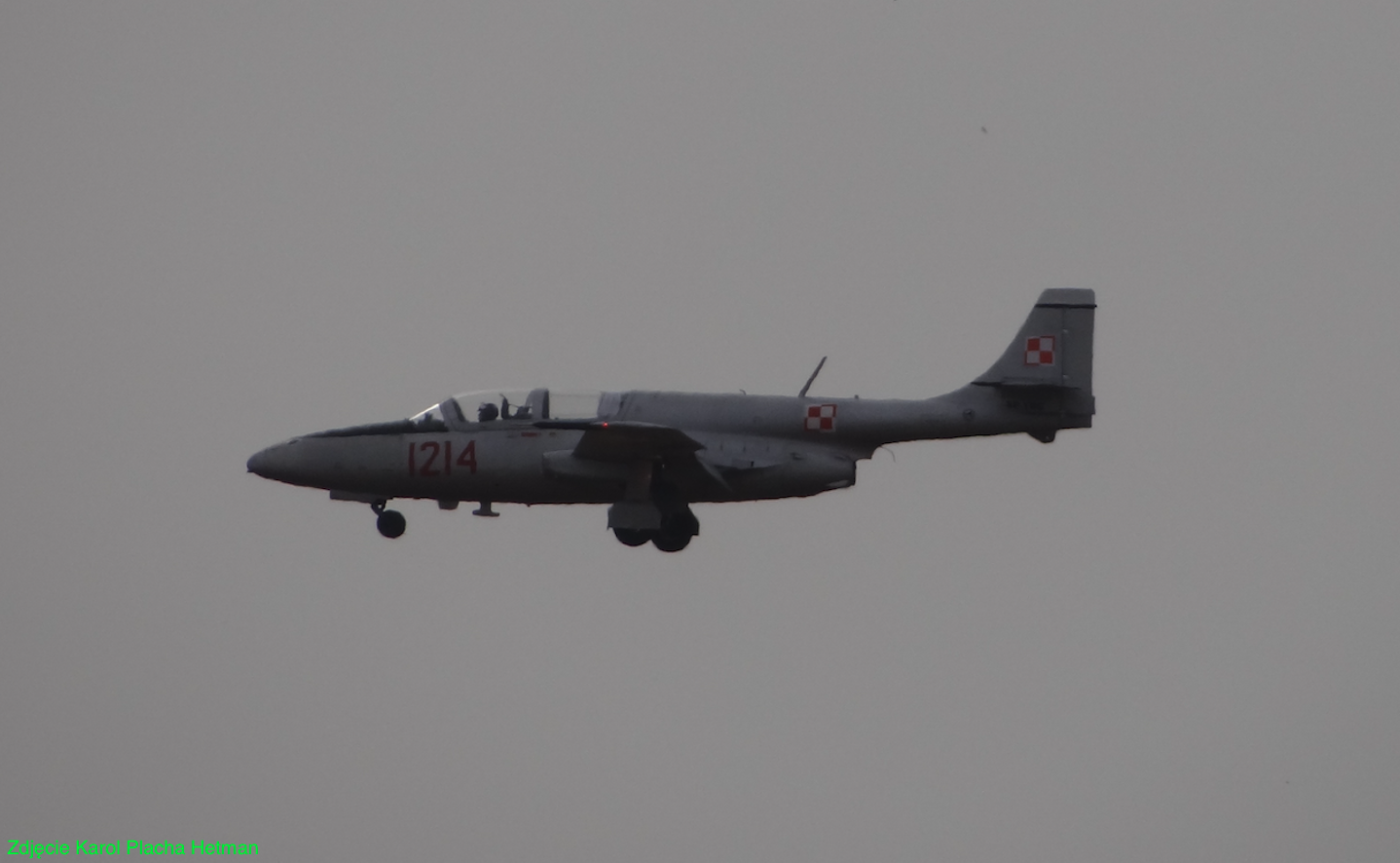Radom 2012-05-24
Lotnisko w Radomiu – Sadków.
Współrzędne geograficzne: 51.388N 21.212E.
Historia Lotniska Radom Sadków. 1958-1989 roku.
1958 rok.
W 1958 roku, nastąpiły w Polskim Lotnictwie Wojskowym poważne zmiany organizacyjne. Postanowiono bowiem, w Lotnictwie Szkolnym przejść z organizacji Eskadr do organizacji Pułków, tak jak to było w jednostkach bojowych. W zamyśle miało to ułatwić dowodzenie jednostkami, a na wypadek „W” wykorzystanie ich bojowo. Dotyczyło to zarówno szkoły w Dęblinie Nr 4, jak i szkoły w Radomiu Nr 5. W miejsce istniejących od maja 1951 roku, eskadr sformowano pułki szkolne i szkolno-bojowe. Każdy pułk posiadał organizacyjnie dwie eskadry szkolne, a każda eskadra miała cztery klucze.
Do zmian przygotowywano się już od 1957 roku, i wydano odpowiednie rozkazy i zarządzenia. Najważniejsze były dwa; Rozkaz organizacyjny MON nr 075/org. z dnia 31.12.1957 roku, oraz Rozkaz organizacyjny DWL i OPL OK nr 02/org. z dnia 29.01.1958 roku. W wyniku realizacji tych rozkazów OSL 5 przeszła na etat nr 20/466, formując następujące jednostki lotnicze: 60 Lotniczy Pułk Szkolno-Bojowy w Radomiu, z dowódcą mjr pil. Feliksem Skrzeczkowskim – samoloty : MiG-15 i MiG-15 UTI. 61 Lotniczy Pułk Szkolno- Bojowy w Nowym Mieście, z dowódcą mjr pil. Józefem Kowalskim – samoloty : MiG-15 i MiG-15UTI. 63 Lotniczy Pułk Szkolno- Bojowy w Tomaszowie Maz. ( Glinnik ) z dowódcą mjr pil. Kazimierzem Ciepielą. Samoloty : MiG-15 i MiG-15UTI. 64 Lotniczy Pułk Szkolny w Przasnyszu, z dowódcą mjr. pil. Henrykiem Andrychowskim – samoloty Junak-3, Jak-11 i TS-8. Przygotowania do reorganizacji prowadzono już wcześniej. Na przełomie 1957/1958 roku, przebazowano 8. Eskadrę z Grójca do Przasnysza.
W dniu 7.11.1957 roku, nastąpił czwarty i ostatni przypadek ucieczki Polskiego Oficera na zachód, przy użyciu myśliwca z rodziny MiG-15. Te ucieczki świadczą tylko o terrorze komunistycznym 50-tych lat, jaki panował w PRL. We wspomnianym dniu, 7.11.1957 roku, (środa), porucznik pilot Bogdan Kożuchowski, z 31 PLM w Łasku, uprowadził samolot Lim-2 nr 1B 19-019 / 1919 do Szwecji. Wskutek błędnej nawigacji wylądował w głębi lądu w okolicy miejscowości Halland. W materiałach źródłowych można znaleźć informację, że poznana turystka ze Szwecji, namówiła porucznika do dezercji, wabiąc urokami życia na Zachodzie. Pan porucznik naiwny, uwierzył. Sądzimy jednak, iż to była nadinterpretacja i gloria systemu komunistycznego, jako najlepszego na świecie. Kary były niezwykle surowe i nie dotyczyły tylko dezertera, ale także jego kolegów, przełożonych i rodzinę. Kilka osób aresztowano i zdegradowano. Cały 31. PLM został dotkliwie ukarany. Przeorientowano jego zadania. Wymieniono samoloty na starsze. Powstanie Poznańskie spowodowało jednak złagodzenie sankcji. Począwszy od 1957 roku, wyroki sądowe dotyczyły wyłącznie uciekinierów. Odpowiedzialnych – nazwijmy to – moralnie karano dyscyplinarnie, ostrzeżeniem, rzadko przeniesieniem na niższe stanowisko. Do końca natomiast karze więzienia towarzyszyło pozbawienie praw obywatelskich, co dotkliwie odczuwały pozostawione w kraju rodziny. Nie zapominajmy, iż w sądach wojskowych nadal przewodzili obywatele sowieccy.
Co to wszystko miało wspólnego ze Szkołą w Radomiu? Otóż, 31. PLM z jednostki bojowej stał się jednostką szkolno-bojową. Utraciwszy znaczną część kadry, otrzymał nowe zadania. Tym razem szkolne. W dniu 12.04.1958 roku, Szkoła w Radomiu przejęła na swój stan 31. PLM z Łasku. Stało się to na podstawie rozkazu DWL i OPL OK nr 07/org. z dnia 22.05.1958 roku, w którym to jednocześnie rozformowano 63. LPSzB bazujący w Glinniku. W okresie od lipca 1958 roku do czerwca 1960 roku, lotnisko w Glinniku nie było eksploatowane.
Decyzją Ministra Obrony Narodowej nr 5 z 31.12.1957 roku, oraz rozkazem Komendanta OSL z 5.02.1958 roku, w ramach zmian struktur organizacyjnych w lotnictwie, powstał 60. Lotniczy Pułk Szkolno – Bojowy, sformowany na bazie istniejących 2 i 5 Eskadry Szkolnej Pilotażu Bojowego, dowodzonych odpowiednio przez: mjr Lipczyńskiego i kpt. Cymbalskiego. Pierwszym dowódcą nowego pułku został mjr pil. Feliks Skrzeczkowski. Na miejsce bazowania wybrano Lotnisko Radom. W wyposażeniu pułku znajdowały się wówczas samoloty MiG-15 UTI, SB Lim-1, Lim-1 i Junak-3. Stan osobowy Pułku uczestniczył w różnych pokazach oraz ćwiczeniach. Jednym z większych pokazów w tym okresie była defilada powietrzna z udziałem 26 pilotów z Radomia w dniu 11.10.1959 roku. Stała się ona zarazem przeglądem poziomu wyszkolenia lotniczego pilotów.
1960 rok.
Lata następne przyniosły Szkole dalsze zmiany organizacyjne. Zgodnie z Rozkazem organizacyjnym nr 07/org. z dnia 22.06.1960 roku. – 64. LPSzB bazujący w Przasnyszu został przekazany do OSL 4 ( Dęblin ). Dokonując kolejnych zmian organizacyjnych powołano do życia kolejny pułk szkolny z miejscem bazowania na lotnisku Glinnik.
Na podstawie tego samego Rozkazu DWL i OPK nr 07/org. z dnia 22.06.1960 roku, powołano do istnienia 66. LPSz w Glinniku, podległy pod OSL 5 w Radomiu. Komendant Szkoły wydał Rozkaz nr 071 z dnia 13.07.1960 roku, który nakazywał wyznaczonemu na dowódcę, mjr. pil. Kazimierzowi Ciepieli, sformować 66. LPSz., wg etatu 22/454, jednostka wojskowa JW. 1071.
Jednostka powstała na bazie dwóch eskadr szkolnych bazujących dotychczas w Krzewicy, pod dowództwem kpt. pil. Władysława Karłowicza i w Ułężu pod dowództwem kpt. pil. Ryszarda Mierzwińskiego. Zalążek organizacyjny Pułku stanowiło dowództwo batalionu zaopatrzenia JW. 3247 i personel II Eskadry Lotniczej jednostki z Nowego Miasta nad Pilicą, który realizował zadania szkoleniowe na lotnisku Glinnik.
W styczniu 1960 roku, do wyposażenia Pułku w Radomiu wszedł nowy samolot Polskiej konstrukcji TS-8 Bies przeznaczony do lotów szkolno-treningowych, który zastąpił samoloty Junak-3.
Sztandar jednostki, nadany uchwałą Rady Państwa PRL z 5.10.1960 roku, został wręczony przez ówczesnego dowódcę Lotnictwa Operacyjnego gen. bryg. pil. Jana Raczkowskiego, w dniu 29.11.1960 roku, w 130-rocznicę wybuchu Powstania Listopadowego.
1964 rok.
Kolejne lata to przygotowanie do przyjęcia do wyposażenia samolotu odrzutowego Polskiej konstrukcji TS-11 Iskra. Równocześnie realizowano szkolenie na samolocie TS-8 Bies. Samolot TS-11 Iskra wszedł do służby w 1964 roku. Ponieważ Lotnisko Radom i 60. LPSzk był pierwszym użytkownikiem tych maszyn w kraju. Dlatego to na personel spadł ciężar opracowania metodyki eksploatacji tych nowoczesnych maszyn. Cały więc 1964 rok, był poświęcony na szkolenie przyszłych instruktorów. Oczywiście wspólnie z pilotami doświadczalnymi z zakładów PZL Mielec. Szkolenie podchorążych rozpoczęto w 1965 roku.
W 1964 roku, Pułk zaczął nowy etap historii. Zarządzeniem Szefa Sztabu Generalnego WP z dnia 8.04.1964 roku, 60 Lotniczy Pułk Szkolno-Bojowy został podporządkowany komendantowi Oficerskiej Szkoły Lotniczej im. Janka Krasickiego w Dęblinie, a zarządzeniem Szefa Sztabu Generalnego WP z 21.12.1964 roku, – przeformowany w 60 Lotniczy Pułk Szkolny. Oznaczało to, że zakończono szkolenie pilotów samolotów myśliwskich (po 14 latach), lecz lotnicze szkolenie podstawowe nadal prowadzono. Ale zmian organizacyjnych to nie był koniec. W 1965 roku, Pułk przeszedł na nowy etat.
1966 rok.
W lipcu 1966 roku, piloci radomskiego Pułku wzięli udział w paradzie powietrznej nad Warszawą, z okazji 1000-lecia Państwa Polskiego. W czasie przelotu na samolotach TS-11 Iskra utworzyli szyk symbolizujący biało-czerwoną szachownicę.
Pokazy lotnicze z udziałem radomskich pilotów zaczynały być wówczas stałym elementem dokumentowania ich wysokiego kunsztu lotniczego. Na stałe zadanie utrzymania zespołu pilotażowego pułk otrzymał 16.02.1969 roku. Od tego dnia datuje się powstanie słynnego radomskiego Rombika. Zespół pilotażowy występował poza granicami kraju – w Belgii, Wielkiej Brytanii, Francji, na Węgrzech, w Czechach i Słowacji.
70-lata XX wieku.
W 70-latach, zadania szkoleniowe były bardzo intensywne, ale systematycznie i spokojnie. Bez gwałtownych zmian organizacyjnych. Większą wagę zaczęto przywiązywać do zdrowia kandydatów na pilotów. Selekcja była dokładniejsza i prowadzono ją w Warszawie. Powodem było to, że przyszli piloci będą prowadzić maszyny bojowe o prędkości naddźwiękowej. Również poziom wiedzy ogólnej kandydatów był znacznie wyższy, co korzystnie wpływało na przyszłość Polskiej Armii. Corocznie w Pułku przeszkalało się kilkudziesięciu podchorążych WSOSP z Dęblina. 60 Lotniczy Pułk Szkolny był wciąż na usługach Szkoły w Dęblinie. W Radomiu szkolono na samolotach; TS-11 Iskra, SB Lim-2, Lim-5 i Lim-6 bis.
W czerwcu 1976 roku, doszło do kolejnych wybuchów niezadowolenia społeczeństwa z komunistycznej władzy. Podstawą były podwyżki cen artykułów przemysłowych i spożywczych. Szczególnie mocne protesty nastąpiły w Radomiu. Na ulicach pojawiły się czołgi. Polała się krew. Zginęli ludzie. Władza wycofała się z części podwyżek wprowadzając pierwsze kartki żywnościowe. Najpierw na cukier. Potem mięso, masło, słodycze, alkohol, wyroby tytoniowe. Doszli aż do kartek na obuwie. Kartki zlikwidowano dopiero w 1987 roku. Wypadki w Radomiu powstrzymały na pewien czas proces szkolenia podchorążych, a jednostkę postawiono w stan gotowości bojowej (przeciw własnemu narodowi).
W dniu 30.01.1979 roku, na Lotnisku Radom-Sadków doszło do katastrofy budowlanej. Pod naporem śniegu runął dach jednego z hangarów, uszkadzając zgromadzone tam 26 samolotów TS-11 Iskra. Zima 1978/1979 roku, była jedną z najcięższych w dziejach PRL i została określona jako Zima Stulecia. Sparaliżowany był transport. Wiele fabryk musiało przerwać produkcję. Na blisko dwa tygodnie zamknięto wszystkie szkoły. Zniszczenie i uszkodzenie tylu samolotów znacząco zakłóciło proces szkolenia młodych pilotów do momentu uzupełnienia maszyn samolotami z innych pułków.
W dniu 13.12.1981 roku, towarzysz generał Wojciech Jaruzelski wprowadził Stan Wojenny, wypowiadając narodowi wojnę i hamując przemiany społeczno-gospodarcze. Proces szkolenia na Lotnisku Radom na kilka miesięcy został wstrzymany. Podchorążych wysłano w patrolach WSW ( Wojskowa Służba Wewnętrzna ) na ulice. Należy pamiętać, iż w tych latach Radom był jednym z najsilniejszych ośrodków przemysłowych w Polsce, a ruch robotniczy był niezwykle silny. Wystarczy przytoczyć protesty robotnicze z 1976 roku. Przestał także występować i trenować lotniczy zespół Rombik (aż do 1984 roku).
80-lata XX wieku.
W dniu 29.09.1983 roku, rozkazem Ministra Obrony Narodowej 60. Lotniczy Pułk Szkolny przyjął imię kpt. pilota Franciszka Żwirki i inż. Stanisława Wigury.
W związku z likwidacją w 1989 roku, 66 Lotniczego Pułku Szkolnego w Tomaszowie Mazowieckim, tamtejsze lotnisko przeszło pod dowództwo Pułku radomskiego, co umożliwiło szkolenie pilotów także na tym obiekcie, do 1995 roku, w ramach 3 eskadry szkolnej pod dowództwem ppłk dypl. pil. Zenona Mackiewicza.
W 1989 roku, zwiększono skład zespołu akrobacyjnego Rombik do 6 maszyn, zmieniając jego nazwę na Biało-Czerwone Iskry. Właśnie wtedy maszyny zostały pomalowane w charakterystyczny biało-czerwony, niezwykle atrakcyjny wzór. W tym malowaniu zespół występuje do chwili obecnej (2020 rok).
III Rzeczypospolita Polska. 1989-2011 rok.
W dniach 1-9.06.1991 roku, Papież Polak Święty Jan Paweł II Wielki odbył swoją czwartą pielgrzymkę do Polski. Po raz pierwszy do wolnej Rzeczypospolitej. Odwiedził między innymi Radom. W dniu 4.06.1991 roku, w Radomiu celebrował Mszę Świętą. Spotkanie z wiernymi odbyło się na płycie Lotniska. Papież wygłosił homilię zaadresowaną do robotników. Ojciec Święty złożył także kwiaty pod monumentem upamiętniającym robotniczy protest i ofiary w czerwcu 1976 roku, przy ul. 25 Czerwca. Tytuł honorowego obywatela Miasta Radomia został nadany Ojcu Świętemu w dniu 30.08.2004 roku.
W 90-tych latach, 60 LPSzk zrealizował kolejne w swojej historii przezbrajanie sprzętowe. Dedykowanym w miejsce TS-11 Iskra był samolot PZL I-22 Iryda. Nowe samoloty trafiły do 58 LPszk, a następnie miały trafić do 60 LPSzk. Jednak te nowe maszyny do Radomia nigdy nie dotarły. W 1996 roku, wszystkie przekazane do tej pory wojsku I-22 Iryda wróciły do Mielca.
Lecz w tym samym okresie, do szkolenia w Rzeczypospolitej zaczęto wprowadzać nowy typ samolotu szkolno-treningowego, PZL-130 Orlik. Samolot, będący przejściem między samolotem tłokowym ( podstawowym ), a szkolno-bojowym z napędem turboodrzutowym, właśnie PZL I-22 Iryda. Pierwszy samolot PZL-130 Orlik wprowadzono w Radomiu do eksploatacji w 1994 roku.
Z końcem 1997 roku, z Lotniska Radom wycofano ostatnie samoloty TS-11 Iskra. Część z nich przekazano do Dęblina, a pozostałe zdjęto ze stanu z uwagi na koniec resursów.
W marcu 1998 roku, powstał Zespół Akrobacyjny Orlik, korzystający z samolotów PZL-130 Orlik. Stało się to na podstawie Rozkazu komendanta Szkoły Orląt w Dęblinie z dnia 1.01.1998 roku. Zespół otrzymał do dyspozycji 4 maszyny, plus jedna do pokazu indywidualnego. Treningi rozpoczęto 15.04.1998 roku. Zespół zaprezentował po raz pierwszy swoje umiejętności na największych wówczas na świecie pokazach lotniczych Air International Tattoo w Faiford w Wielkiej Brytanii. Seria udanych pokazów spowodowała rozrost zespołu do siedmiu maszyn. W kolejnych latach uświetniał swoją obecnością krajowe pokazy w Dęblinie, Radomiu oraz międzynarodowe w Czechach, Francji, Wielkiej Brytanii, na Litwie i Słowacji. W 2001 roku, rozszerzono skład zespołu do siedmiu maszyn, a dwa lata później (2003 rok) do dziewięciu.
2000 rok.
W 1999 roku, Rzeczypospolita wstąpiła do układu NATO. Wywołało to szereg reorganizacji i przeformowań poszczególnych jednostek. W 2000 roku, 60 LPSzk przeszedł przemiany strukturalne. Oficjalnie 28.12.2000 roku, 60 Lotniczy Pułk Szkolny został zlikwidowany. W tym dniu w jednym z hangarów odbyła się ceremonia pożegnania sztandaru, który został przekazany do Muzeum Wojska Polskiego.
Od dnia 1.01.2001 roku, Rozkazem szefa sztabu generalnego WP na bazie 60 LPSzk powstał 2 Ośrodek Szkolenia Lotniczego i Komenda Lotniska Nr 2. Oba jako pododdziały w strukturach 6 Bazy Lotniczej w Dęblinie. Pierwszym dowódcą ośrodka został płk dypl. pil. Marek Bylinka, natomiast komendy lotniska mjr Sławomir Grychtal.
Podczas swego istnienia 60 LPSzk był wielokrotnie nagradzany. Niektóre nagrody i wyróżnienie pułku: Krzyż Komandorski Orderu Odrodzenia Polski. medal "za Wybitne Osiągnięcia w Służbie Wojskowej", liczne puchary za bezpieczeństwo lotów.Dowódcy 60. LPSzk.
Przez 42 lata istnienia Pułku kierowali nim następujący dowódcy: ppłk dypl. pil. Feliks Skrzeczkowski, ppłk dypl. pil. Marian Lipczyński, ppłk dypl. pil. Stanisław Madej, ppłk dypl. pil. Franciszek Macioła, ppłk dypl. pil. Ryszard Olszewski, płk dypl. pil. Ryszard Leszczyński, płk dypl. pil. Bogusław Deja, płk pil. dr Marek Bylinka – zarazem pierwszy dowódca 2 OSL.
2001 rok.
W 2000 roku, na skutek przekształceń w Wojskach Lotniczych nastąpiło przebazowanie zespołu akrobacyjnego Biało-Czerwone Iskry do Dęblina, z symbolicznym jego przekazaniem w dniu 17.06.2000 roku.
Jesienią 2001 roku, 2 OSzL uzyskał zgodę na posiadanie sztandaru. Uroczystość jego wręczenia odbyła się w dniu 10.11.2001 roku, w Radomiu. Od dnia 23.03.2003 roku, ośrodkiem dowodzi płk dypl. pil. Jerzy Chojnowski, który pełni jednocześnie funkcję dowódcy Garnizonu Radom.
2004 rok.
W czerwcu 2004 roku, Komenda Lotniska nr 2 została przeformowana. W miejsce dotychczasowego pododdziału powstała samodzielna jednostka logistyczna Sił Powietrznych pod nazwą 1 Komenda Lotniska (JW. 3463). Oficjalnie 1 Komenda Lotniska funkcjonuje od 1.07.2004 roku. Samodzielność Komendy trawa jednak krótko, bo została podporządkowana pod Wyższą Szkołę Oficerską Sił Powietrznych w Dęblinie.
2 Ośrodek Szkolenia Lotniczego w Radomiu imienia kpt. pil. Franciszka Żwirki i inż. Stanisława Wigury był jednostką szkoleniową Sił Powietrznych. Zajmował się szkoleniem praktycznym na samolotach PZL-130 Orlik podchorążych Wyższej Szkoły Oficerskiej Sił Powietrznych w Dęblinie oraz utrzymywał w gotowości do pokazów zespół akrobacyjny Orlik. Szkolono podchorążych pierwszego i drugiego roku studiów. Okres lotny rozpoczynał się z początkiem marca. Studenci przybywali do Radomia już w lutym, by przez pierwszy miesiąc utrwalać wiedzę teoretyczną o pilotażu samolotu PZL-130 Orlik i wykonywać loty na symulatorze. Po egzaminie teoretycznym przystępowali do pierwszych lotów na PZL-130.
Natomiast 1. Komenda Lotniska w Radomiu była jednostką logistyczną Sił Powietrznych i zabezpieczała szkolenie pod względem logistycznym. 2 OSzL i 1 KL były jednostkami wojskowymi wchodzącymi w skład 4 Skrzydła Lotnictwa Szkolnego w Dęblinie.
Ten nie do końca przejrzysty podział funkcji powodował częsty dualizm funkcji i czasami brak kompetencji. W rezultacie musiano zawrzeć porozumienie, które dopracowywało kompetencje. Jednocześnie umożliwiło podjęcie wspólnych działań na rzecz cywilnego środowiska. Można było objąć patronatem wojskowym klasy szkolne o profilu wojskowym w szkołach ZDZ ( Związku Doskonalenia Zawodowego ) na terenie Województwa Mazowieckiego w Radomiu i Nowym Mieście. Między tymi placówkami, a Oddziałem ZDZ w Radomiu została podpisana umowa o współpracy na rzecz promowania obronności, szkolnictwa wojskowego i zawodowej służby wojskowej, przybliżająca uczniów klas „wojskowych” szkół ZDZ do zrealizowania planów przyszłej pracy w Polskiej Armii, a w szczególności w Siłach Powietrznych RP. Porozumie partnerów objęło organizowanie konferencji, uroczystości wojskowych i szkoleń. Festynów, turniejów, konkursów, spartakiad, a także szereg innych masowych imprez upowszechniających tradycje wychowania patriotycznego i wojskowego. Wojskowa kadra dydaktyczna udzielała pedagogom ze szkół ZDZ pomocy merytorycznej w prowadzeniu zajęć dotyczących Sił Zbrojnych i problemów specjalistycznych. Wojskowi udostępniali materiały informacyjno-edukacyjne, szkoleniowe i promujące wychowanie wojskowe oraz materiały poglądowe. Pomagali również prowadzić na terenie jednostki wojskowej zajęcia dydaktyczne związane z obronnością.
Do zadań 1. Komendy Lotniska (JW. 3463) należało; Utrzymywanie i odtwarzanie sprawności technicznej uzbrojenia i sprzętu wojskowego. Gromadzenie (magazynowanie), zaopatrywanie i planowanie dostaw materiałowych dla potrzeb pododdziałów. Utrzymywanie i odtwarzanie gotowości eksploatacyjnej Lotniska ( utrzymanie infrastruktury ). 1 Komenda Lotniska swoje święto obchodziła w dniu 1 lipca. Ustalono je decyzją Nr 350/MON z dnia 3.08.2007 roku.
Dowódcy 1 Komendy Lotniska Radom Sadków; Płk dypl pilot Jerzy Chonowski – 1.07.2004r.-5.06.2006r. Ppłk mgr Krzysztof Baranowski – 5.06.2006r.-31.12.2010r. Ostatni dowódcy w 1 Komendzie Lotniska Radom Sadków. ppłk mgr Krzysztof Baronowski – dowódca od 5.06.2006r.-31.12.2010r. mjr Jacek Jaźwic – zastępca d-cy. mjr Janusz Orzechowski – Szef Sztabu mjr Marek Ziębicki – szef Logistyki. mjr Andrzej Wójtowicz – szef Szkolenia. Podporządkowanie – Wyższa Oficerska Szkoła Sił Powietrznych – 1.07.2004r.-17.12.2008r. potem 4 Skrzydło Lotnictwa Szkolnego – 17.12.2008r.-31.12.2010r.
1 Komenda Lotniska Radom zabezpieczała zadania; 2 Ośrodka Szkolenia Lotniczego, 4 WOM ( Wojskowy Ośrodek Meteorologii ), Wojskowa Komenda Uzupełnień Radom, Wojskowa Specjalistyczna Przychodnia Lekarska ( WSPL ), Pracowania Psychologiczna, Rejonowe Przedstawicielstwo Wojskowe, Placówka Żandarmerii Wojskowej ( ŻW ), Wojskowa Agencja Mieszkaniowa ( WAM ).
2011 rok.
Nie upłynęło kilkanaście miesięcy, a nastąpiły kolejne zmiany organizacyjne, potwierdzające zapaść Polskich Sił Zbrojnych. Zgodnie z Decyzją Ministra Obrony Narodowej ( słabiutkiego ministra Bogdana Kicha, zdymisjonowanego 2.08.2011 roku, w wyniku wypadków związanych z zamachem smoleńskim ) 2 Ośrodek Szkolenia Lotniczego i 1 Komenda Lotniska zostały przeformowane z dniem 1.01.2011 roku, w 42 Bazę Lotnictwa Szkolnego.
Dlatego zgodnie z „Ceremoniałem Wojskowym Sił Zbrojnych RP”, 10.12.2010 roku, odbyło się na radomskim lotnisku wojskowym uroczyste pożegnanie sztandarów 2 OSzL i 1 KL. Wystąpił z przemówieniem nowy dowódca 42 Bazy Lotnictwa Szkolnego płk Adam Ziółkowski i podziękował wszystkim żołnierzom i pracownikom wojska za dotychczasową służbę, ale również nakreślił zadania i wyzwania stojące przed nową jednostką. Uroczystość pożegnania sztandarów zakończyła się podpisaniem aktu przeformowania jednostek w Sali Tradycji Radomskiego Garnizonu. W tym symbolicznym akcie uczestniczyli: dowódcy jednostek, poczty sztandarowe, fundatorzy sztandarów przedstawiciele władz administracyjnych i samorządowych regionu, duszpasterstwa wojskowego, organizacji pozarządowych i środowisk kombatanckich. Apel wojskowy uświetniła kompania Reprezentacyjna Sił Powietrznych i Orkiestra Garnizonowa Sił Powietrznych z Radomia.
Jednostki Lotnictwa Polskiego w Radomiu, zestawienie:
Eskadra Szkolna Pilotów 1927r.-1935r. Szkoła Pilotów Rezerwy 1935r.-1939r. Szkoła Podchorążych Rezerwy Lotnictwa 1937r.-1939r. Okres okupacji armii niemieckiej 1939r.-1945r. 15 Zapasowy Pułk Lotniczy z dowództwem w Dęblinie 1945r.-1951r. Oficerska Szkoła Lotnicza nr 5 im. Żwirki i Wigury 1951r.-1964r. 60 Lotniczy Pułk Szkolno-Bojowy 1958r.-1964r. Oficerska Szkoła Lotnicza podporządkowana Szkole w Dęblinie 1964r.-1968r. 60 Lotniczy Pułk Szkolny 1964r.-2000r. Wyższa Oficerska Szkoła Lotnicza podporządkowana Szkole w Dęblinie 1968r.-2000r. Ośrodek Szkolenia Lotniczego podporządkowany Szkole w Dęblinie 2000r.-31.12.2010r. Komenda Lotniska nr 2 jako pododdział logistyczny w strukturach 6 Bazy Lotniczej w Dęblinie 2000r.-2004r. 1 Komenda Lotniska ( JW. 3463 ) 1.07.2004r.-31.12.2010r. 42 Baza Lotnictwa Szkolnego 1.01.2011r.-…
Adres; Lotnisko Radom Sadków. Ulica Lubelska 150, 26-600 Radom. Telefony; 48-351-1290, 48-351-1330, faks 48-351-1555.
Pokazy lotnicze – Air Show Radom.
Od 2000 roku, na lotnisku Radom Sadków są organizowane wielkie pokazy lotnicze wojskowe i cywilne. Pokazy Air Show w Rzeczypospolitej Polskiej to wielkie imprezy lotnicze, których głównym organizatorem jest Polskie Lotnictwo Wojskowe, zwane obecnie Polskimi Siłami Powietrznymi. Główną cechą tych pokazów jest udział zagranicznych gości, głównie przedstawicieli lotnictwa wojskowego. Imprezy te zawsze są związane z obchodami Polskiego Święta Lotnictwa (obchodzone w dniu 28 sierpnia). Celem Międzynarodowych Pokazów Lotniczych Air Show jest przybliżenie narodowi realiów lotniczego życia tych co bronią Polskiego Nieba. Ich szkolenia, treningu i misji bojowych. Zademonstrowanie strony Polskiej na tle innych państw, nie zawsze bardzo nam przychylnych. Zademonstrowanie sztuki walki powietrznej, kunsztu wyższego pilotażu, a wręcz cyrkowych popisów. Wszystko co widz ma oglądać na ziemi i w powietrzu jest przemyślane, starannie zaplanowane i poukładane. Nie ma dwóch identycznych pokazów. Każdy ma swoją specyfikę.
Air Show w Wolnej Polsce początkowo były organizowane nieregularnie i na różnych lotniskach. Dopiero od 2000 roku, stałym miejscem stało się Lotnisko Radom – Sadków, a od 2003 roku, impreza odbywa się cyklicznie, co dwa lata.
Pierwsza impreza Air Show ( I ) odbyła się w 1991 roku, na Lotnisku Ławica. Następny Air Show II zorganizowano dopiero w 1995 roku, na Lotnisku Dęblin. Air Show III zorganizowano w 1996 roku, na Lotnisku Bydgoszcz. Air Show IV ponownie przeprowadzono na Lotnisku Dęblin w 1998 roku. W 2000 roku, Air Show V przeprowadzono po raz pierwszy na Lotnisku Radom. W 2001 roku, Air Show VI Radom. W 2002 roku, Air Show VII Radom. W 2003 roku, Air Show VIII Radom. Dalej co dwa lata. W 2005 roku, Air Show IX Radom. W 2007 roku, Air Show X Radom. W 2009 roku, Air Show XI Radom. W 2011 roku, Air Show XII Radom. W 2013 roku, Air Show XIII Radom. W 2015 roku, Air Show XIV Radom. W 2017 roku, Air Show XV Radom (ta impreza miała się nie odbyć, ale minister Antoni Macierewicz dotrzymał słowa). W 2018 roku, Air Show XVI Radom (ta impreza była z okazji 100-lecia odzyskania niepodległości przez Polskę). W 2020 roku nie było imprezy, bo była pandemia korona-wirusa.
W tym miejscu należy zaznaczyć, iż w innych latach także były organizowane imprezy, które czasami określano Air Show, lecz nie były zaliczone do tego cyklu. Były one zorganizowane w Bydgoszczy, Dęblinie, Gdyni i Mielcu. Więcej na ten temat w osobnych rozdziałach i artykułach.
Opracował Karol Placha Hetman






